 |
 |
 |
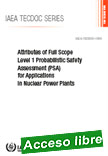 |
Attributes of Full Scope Level 1 Probabilistic Safety Assessment (PSA) for Applications in Nuclear Power Plants
IAEA TECDOC, 2016, 331 p.
This publication aims to further promote the use and application of PSA in Member States by providing a comprehensive list of PSA applications and describing what technical features (termed ‘attributes’) need to be satisfied to reliably support them. Consideration has also been given to the basic set of attributes characterizing a ‘base case PSA’ that is performed to assess overall plant safety. |
The present publication can support PSA practitioners in appropriate planning of a PSA project taking into account possible uses of the PSA in the future. It can also be used by reviewers as an aid in assessing the quality of PSAs and judging the adequacy of a PSA for particular applications.
Extraído de: http://pub.iaea.org/books/IAEABooks/10969/Attributes-of-Full-Scope-Level-1-Probabilistic-Safety-Assessment-PSA-for-Applications-in-Nuclear-Power-Plants
|
 |
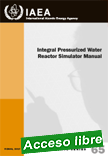 |
Integral Pressurized Water Reactor Simulator Manual
IAEA Training Course Series, 2017, 120 p.
This publication provides detailed explanations of the theoretical concepts that the simulator users have to know to gain a comprehensive understanding of the physics and technology of integral pressurized water reactors. It provides explanations of each of the simulator screens and various controls that a user can monitor and modify. A complete description of all the simulator features is also provided. A detailed set of exercises is provided in the Exercise Handbook accompanying this publication. |
Extraído de: http://pub.iaea.org/books/IAEABooks/12201/Integral-Pressurized-Water-Reactor-Simulator-Manual
|
 |
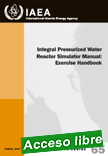 |
Integral Pressurized Water Reactor Simulator Manual: Exercise Handbook
IAEA Training Course Series, 2017, No. 65, 126 p.
This Exercise Handbook accompanies Training Course Series No. 65, Integral Pressurized Water Reactor Simulator Manual. It contains practical exercises as part of the educational and training material provided during IAEA training courses and workshops. The Manual provides an explanation of the theoretical concepts of integral pressurized water reactors and a description of the simulator’s features. The Exercise Handbook complements this by providing detailed, step by step operating instructions together with the required explanations to run various normal operations and transients in the simulator.
|
Extraído de: http://pub.iaea.org/books/IAEABooks/12202/Integral-Pressurized-Water-Reactor-Simulator-Manual-Exercise-Handbook
|
 |
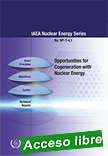 |
This publication presents a comprehensive overview of various aspects relating to the application of cogeneration with nuclear energy, which may offer advantages such as increased efficiency, better cost effectiveness, and reduced environmental impact. The publication provides details on experiences, best practices and expectations for the foreseeable future of cogeneration with nuclear power technology and serves as a guide that supports newcomer countries. It includes information on systems and applications in various sectors, feasibility aspects, technical and economic details, and case studies.
|
Extraído de: http://pub.iaea.org/books/IAEABooks/10877/Opportunities-for-Cogeneration-with-Nuclear-Energy
|
 |
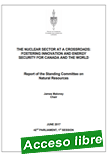 |
The Future of Canada’s Oil and Gas, Mining and Nuclear Sectors: Innovation, Sustainable Solutions and Economic Opportunities
House of Commons Standing Committee on Natural Resources (Canada), June 2017, 44 p.
On June 9, 2017, the House of Commons Standing Committee on Natural Resources tabled the fifth report in its study of The Future of Canada’s Oil and Gas, Mining and Nuclear Sectors: Innovation, Sustainable Solutions and Economic Opportunities. The report, titled The Nuclear Sector at a Crossroads: Fostering Innovation and Energy Security for Canada and the World, provides an overview of the nuclear sector in Canada, discusses the restructuring of Atomic Energy of Canada Limited, |
the Commissioner of the Environment and Sustainable Development’s 2016 Audit of the Canadian Nuclear Safety Commission, and waste management and decommissioning. The report concludes with a list of recommendations by the Committee.
Extraído de: http://nuclearsafety.gc.ca/eng/resources/perspectives-on-nuclear-issues/
Site: http://www.ourcommons.ca/DocumentViewer/en/42-1/RNNR/report-5/page-5
Report: http://www.ourcommons.ca/Content/Committee/.../rnnrrp05-e.pdf
|
 |
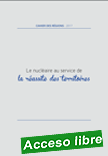
|
Le Nucléaire au Service de la Réussite des Territoires
Société Française d’Energie Nucléaire (SFEN), 2017, 46 p.
Pour la première fois la SFEN publie un atlas des régions françaises qui rend compte de l’ancrage de l’industrie nucléaire dans les territoires, de sa contribution à leur dynamisme économique, et enfin de son apport aux projets de transition écologique et solidaire. |
Extraído de: http://www.sfen.org/sites/default/files/public/atoms/files/sfen-cahier-des-regions-_le_nucleaire_au_service_de_la_reussite_des_territoires-_2017.pdf
|
 |
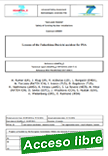 |
Lessons of the Fukushima Dai-ichi accident for PSA
Advanced Safety Assessment Methodologies: extended PSA (European research Project), 31 December 2016, 112 p.
The objective of this document is to identify some lessons learned from the Fukushima Dai-ichi accident for PSA. Based on the public information on the causes that have led to major radioactive release during the Fukushima Dai-ichi accident (initiating events, material and human response), the authors, ASAMPSA_E WP30 members have performed a review to examine the gaps/insufficiencies/incompleteness in the existing Level 1 and Level 2 PSAs.
|
This is the aim of this report which is one of WP30 deliverables i.e. D30.2. The consideration of
external initiating events for the different levels of defense-in-depth is one of the focal points in this review.
Recommendations in the way of developing the different elements of PSAs have been proposed by the authors and were completed later during the ASAMPSA_E project. Moreover, first recommendations on the use of PSA information in decision making have been included as well.
Extraído de: http://asampsa.eu/wp-content/uploads/2014/10/ASAMPSA_E-WP30-D30_2_Lessons_of-FKS_Daiichi_accident_for_PSA.pdf
Deliverables & Library – List of ASAMPSA Reports: http://asampsa.eu/deliverables-library/
|
 |
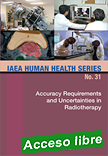 |
Accuracy Requirements and Uncertainties in Radiotherapy
IAEA Human Health Series, 2016, 297 p..
Accuracy requirements in radiation oncology have been defined in multiple publications; however, these have been based on differing radiation technologies. In the meantime, the uncertainties in radiation dosimetry reference standards have been reduced and more detailed patient outcome data are available. No comprehensive literature on accuracy and uncertainties in radiotherapy has been published so far. |
The IAEA has therefore developed a new international consensus document on accuracy requirements and uncertainties in radiation therapy, to promote safer and more effective patient treatments. This publication addresses accuracy and uncertainty issues related to the vast majority of radiotherapy departments including both external beam radiotherapy and brachytherapy. It covers clinical, radiobiological, dosimetric, technical and physical aspects.
Extraído de: http://pub.iaea.org/books/IAEABooks/10668/Accuracy-Requirements-and-Uncertainties-in-Radiotherapy
|
 |
|
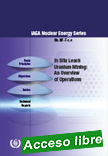
|
In Situ Leach Uranium Mining: An Overview of Operations
IAEA Nuclear Energy Series, 2016, 60 p.
In situ leach or leaching (ISL) or in situ recovery (ISR) mining has become one of the standard uranium production methods. Its application to amenable uranium deposits (in certain sedimentary formations) has been growing in view of its competitive production costs and low surface impacts. This publication provides an historical overview and shows how ISL experience around the world can be used to direct the development of technical activities,
|
taking into account environmental considerations, and emphasizing the economics of the process, including responsible mine closure. The publication provides information on how to design, operate and regulate current and future projects safely and efficiently, with a view to maximizing performance and minimizing negative environmental impact.
Extraído de: http://pub.iaea.org/books/IAEABooks/10974/In-Situ-Leach-Uranium-Mining-An-Overview-of-Operations
|
 |
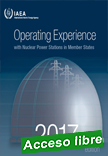 |
Operating Experience with Nuclear Power Stations in Member States in 2016 - 2017 Edition
IAEA Operating Experience with Nuclear Power Stations in Member States (CD-ROM), 2017, 1.555 p.
This CD-ROM contains the 48th edition of the IAEA’s series of annual reports on operating experience with nuclear power plants in Member States. It is a direct output from the IAEA’s Power Reactor Information System (PRIS) and contains information on electricity production and overall performance of individual plants during 2016.
|
In addition to annual information, the report contains a historical summary of performance during the lifetime of individual plants and figures illustrating worldwide performance of the nuclear industry. The CD-ROM also contains an overview of design characteristics and dashboards of all operating nuclear power plants worldwide.
Extraído de: http://pub.iaea.org/books/IAEABooks/12246/Operating-Experience-with-Nuclear-Power-Stations-in-Member-States-in-2016
|
 |
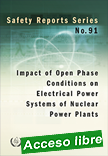 |
Impact of Open Phase Conditions on Electrical Power Systems of Nuclear Power Plants
IAEA Safety Reports Series, 2016, 92 p.
An open phase condition is a known phenomenon in the power industry and is recognized to have had an adverse impact on the electrical power systems in several nuclear power plants. An open phase condition may challenge plant safety systems. Operationg experience in different countries has shown that currently installed instrumentation and protective schemes have not been adequate to detect this condition and initiate appropriate action.
|
|
 |
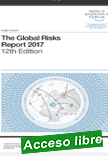 |
The Global Risks Report 2017
World Economic Forum (WEF), 2017, 78 p.
The Global Risks Report 2017 features perspectives from nearly 750 experts on the perceived impact and likelihood of 30 prevalent global risks as well as 13 underlying trends that could amplify them or alter the interconnections between them over a 10-year timeframe.
|
2016 saw a crystallization of political risks that have led to the election of populist leaders, a loss of faith in institutions and increased strain on international cooperation. We should not be surprised by this: for the past decade, the Global Risks Report has been drawing attention to persistent economic, social and political factors that have been shaping our risks landscape.
This year’s report will examine the five greatest priorities facing the world in 2017, their interconnections and the actions necessary to avoid their harshest fall-out.
.
Extraído de: https://www.weforum.org/reports/the-global-risks-report-2017
|
 |
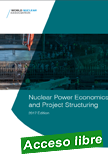 |
Nuclear Power Economics and Project Structuring 2017 Edition
World Nuclear Association, 2017, 48 p.
Nuclear power is an economic source of electricity generation, combining the advantages of security, reliability, virtually zero greenhouse gas emissions and cost competitiveness. Existing plants function well with a high degree of predictability. The operating costs of these plants are usually very competitive, with a low risk of significant operating cost inflation. The capacity factors of existing plants are high (over 90% in the US). Nuclear power plants provide electricity when it is needed. Plants are now expected to operate for 60 years and even longer in future.
|
The International Energy Agency (IEA) sees the global demand for electricity growing at 1.9% per year in the period to 2040. Given this demand environment, coupled with the desire to reduce the greenhouse gas emissions from the generation of electricity, the IEA projects growth of an annualised 2.3% in nuclear generation over that period.Nuclear competes well with rival generation technologies as is indicated by the assessment of the Organisation for Economic Cooperation and Development (OECD) - Nuclear Energy Agency (NEA) & IEA, although the level of competitiveness does vary at different discount rates and between countries. In the pivotal Chinese market, nuclear has a lower levelised cost of generating electricity (LCOE) than any other technology barring hydro.In some electricity markets, especially those that are deregulated, subsidised intermittent renewable generation and gas-fired generation not penalised by carbon costs are creating economic difficulties for all baseload generators, including nuclear. Where the system and external costs of competitor technologies are added to the plant-level costs, the competitiveness of nuclear is enhanced. In order for these advantages of nuclear to be fully realised, policymakers need to address fundamental market design problems. In some countries, deregulated markets are being partially re-regulated in order to place monetary value on the qualities that nuclear power brings (reliability, security, zero emissions).The economics of new nuclear plants are heavily influenced by their capital cost, which accounts for at least 60% of their levelised cost of electricity. Interest charges and the construction period are important variables for determining the overall cost of capital. The escalation of nuclear capital costs in some countries, more apparent than real given the paucity of new reactor construction in OECD countries and the introduction of new designs, has peaked in the opinion of the IEA3. In countries where continuous development programmes have been maintained, capital costs have been contained and, in the case of South Korea, even reduced. Over the last fifteen years global median construction periods have fallen. Once a nuclear plant has been constructed, the production cost of electricity is low and predictably stable.Economic risks relate to a range of factors including: the regulation of electricity markets and the existence of competitor technologies that are subsidised or fail to account for external costs; nuclear safety regulation; project construction performance; operational performance; and political risk. Some of these risks can be managed by the reactor engineering, procurement and construction contractors or the utility but others are outside the control of the industry. In practice, current nuclear investment is undertaken in broadly regulated markets largely via utility balance sheet financing where the operator can offset the risks of any given generating technology against those of other assets in their portfolio. Most electricity markets are regulated and characterised by dominant state-owned companies.
.
Extraído de: http://world-nuclear.org/our-association/publications/online-reports/nuclear-power-economics-and-project-structuring.aspx
|
 |
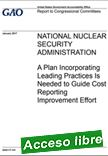 |
National Nuclear Security Administration: A Plan Incorporating Leading Practices Is Needed to Guide Cost Reporting Improvement Effort
Government Accountability Office (GAO - US), January 19, 2017, 26 p.
Effective management and oversight of contracts, projects, and programs are dependent upon the availability of reliable enterprise-wide financial management information. Such information is also needed by Congress to carry out its oversight responsibilities and make budgetary decisions.
|
However, meaningful cost analysis of NNSA programs, including comparisons across programs, contractors, and sites, is not possible because NNSA’s contractors use different methods of accounting for and tracking costs.
The National Defense Authorization Act for Fiscal Year 2014 required NNSA to develop and submit to Congress a plan to improve and integrate its financial management. An explanatory statement accompanying the act included a provision for GAO to review the adequacy of NNSA’s plan.
This report evaluates the extent to which NNSA’s plan (1) addresses the objectives of the act and (2) follows leading practices for planning. GAO reviewed NNSA’s plan and compared it with legislative requirements and leading practices for planning and interviewed NNSA officials.
.
Extraído de: http://www.gao.gov/assets/690/682186.pdf |
 |
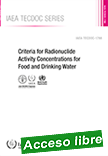 |
Criteria for Radionuclide Activity Concentrations for Food and Drinking Water
IAEA TECDOC, 2016, 63 p.
This publication considers the various international standards to be applied at the national level for the assessment of levels of radionuclides in food and in drinking water in different circumstances for the purposes of control, other than in a nuclear or radiological emergency. It collates and provides an overview of the different criteria used in assessing and controlling the radionuclide content of food and drinking water.
|
The approach used to derive reference levels of radionuclide activity concentration in food and in drinking water as criteria for use in particular circumstances is also considered. This publication is intended for the use by regulatory bodies, policy makers and interested parties with responsibilities in relation to the management of various situations where radionuclides are, or could be, present in food and in drinking water, other than in a nuclear or radiological emergency
Extraído de: http://pub.iaea.org/books/iaeabooks/11061/Criteria-for-Radionuclide-Activity-Concentrations-for-Food-and-Drinking-Water |
 |
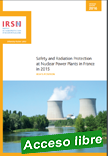 |
IRSN's Position on Safety and Radiation Protection at Nuclear Power Plants in France in 2015
Institut de Radioprotection et de Sûreté Nucléaire (IRSN), 09/03/2017, 56 p.
IRSN publishes its report on the operation, in 2015, of the 58 nuclear reactors of EDF in France. It is based on an overall review of significant events, which brings out global lessons as well as trends in evolution and identifies topics requiring special attention.
In its report, the Institute presents the overall assessment of the significant events reported by EDF to the Nuclear Safety Authority (ASN) and highlights the most noteworthy events of the year.
|
Extraído de: http://www.irsn.fr/EN/publications/technical-publications/Pages/technical-safety.aspx |
| |
| |
|
|
| |
| |
|
|
| |
| |
|
|
| |
| |
|
|
|
